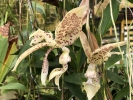|
|
|
|
|
| |
Flasks of
Stanhopea costaricensis 'Schonfeld Trophy' × 'Kerspe 9/84' |
|
| |
|
|
| |
| Number: |
TN5722 |
| Name: |
Stanhopea costaricensis 'Schonfeld Trophy' × 'Kerspe 9/84'
|
| Type: |
outcross (What's that?) |
|
Click to Enlarge

Pod Parent Flower |
Click to Enlarge

Pod Parent Closeup of Hypochiles |
Click to Enlarge

Pod Parent Inflorescence |
Click to Enlarge

Pollen Parent Flower |
Click to Enlarge

Pollen Parent Inflorescence |
Click to Enlarge

Offspring 'MC6903' Flower |
| Offspring photos are siblings of the plants you would receive. |
|
|
|
| |
Culture Notes from Donor: Parent plants: Temperature range I (60-83°F)
Comments: Pod parent plant: Surprising, strong, pleasant fragrance very much like freshly sawn pitchy pine boards.
Pollen parent plant: Positively identified as one of the many forms of Stanhopea costaricensis by Rudolf Jenny using photographs and pickled flowers. Flowers have a pleasant fragrance of freshly-sawn pine boards.
For additional origin/habitat information supplied courtesy of
Charles and Margaret Baker, see further below, near the bottom of this page.
|
Temperatures we attempt to use in the lab & greenhouse:
| For Species: |
|
Spring, Summer, Autumn, Winter: days average 75°F, nights 62°F; best fit is Cool-Intermediate 75-58°F
(Source:
Baker's Web OSC) |
|
About the name...
| Etymology of |
costaricensis |
|
Means "from Costa Rica"
(Source:
Mayr & Schmucker 1998) |
| Etymology of |
Stanhopea |
|
In honor of Philip Henry, 4th Earl of Stanhope, president of the London Medico-Botanical Society during the early part of the 19th century.
(Source:
Pridgeon 1992) |
| Pronunciation of |
costaricensis |
|
kos-ta-ree-SEN-sis
(Source:
Hawkes 1978) |
| Pronunciation of |
Stanhopea |
|
stan-HOPE-ee-ah
(Source:
Pridgeon 1992) |
|
If you would like to direct someone to this web page, please copy and paste this URL into your email:
http://troymeyers.com/d?015722
| Flask Information |
| Availability: |
We have sold all of the flasks for this item. |
| You should: |
Consider getting individual plants or compots instead of a flask.
You can place a "Notify Flask Recipients" Request, and either we or a flask recipient may contact you when plants are available.
You may also place a "Notify Retries" Request, and if an identical pollination (the same parents) is done again, we'll let you know.
You may reserve a flask, but it's very unlikely you'll get one ...this could only happen if we found a flask that we didn't know we had. |
| Yield Estimate: |
360 plants (based on flask surveys done 11/02/2007 through 12/11/2007)
|
| Plantlet Sizes: |
From many flasks 40 - 100 mm plants (based on flask surveys done 03/11/2008 through 05/13/2008)
From one most recently surveyed flask 70 - 100 mm (05/13/2008)
|
|
You might also want to:
|
View the seed assay for this item.
View items of the same species.
View items of the same genus.
|
| Ordering Information |
| You are not currently logged in. |
|
You must be a registered user and be logged in to reserve a flask or place a notification request. Please log in:
|
|
|
|
|
|
| |
The origin/habitat information below is supplied courtesy of Charles and Margaret Baker
The following information is based on the name of the plant provided by the donor, and assumes that the name is correct. If the plant has been misidentified, then the following information may not be correct.
This text is copyrighted by the Bakers and may not be reproduced without permission.
ORIGIN/HABITAT: Nicaragua, El Salvador, Costa Rica, and Panama. Plants
grow in intermediate evergreen or cloud and rainforests, mostly on the
Caribbean watershed. In Panama and Costa Rica, this orchid grows at
1650-4900 ft. (500-1500 m) in moist, mistforest habitat.
More about this information and the Bakers...
|
|
|
| |
|
|
|